How much does the practice of video games affect our imagination? Are video games shaping our perception of reality or is it our perception of reality that shapes the imagination behind video games?
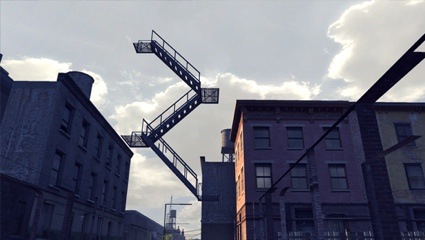 Robert Overweg, Stairway to the sky 2011, Mafia 2
Robert Overweg, Stairway to the sky 2011, Mafia 2
 Robert Overweg, Hotel 2011, Mafia 2
Robert Overweg, Hotel 2011, Mafia 2
On the one hand, the move from 2D image to 3D image in video games has accelerated the race to ultra-realism. Ironically, reality has been lost in the process. By striving to mimic reality, 3D images become hyper realistic, they are slick and clean to the point of looking almost unreal. A game supposed to reflect life ends up proposing only a constructed reflect of life. This reflection, in turn, influences the way we see and imagine our surrounding.
On the other hand, we’ve been observing a revival of pixelated, ASCII, Cubist or simply geometric games. They give more room for imagination and reflection, as if the mind could fill the spaces between the pixels, the voids, the geometric shapes.
Games Reflexions, an exhibition that will open next week in Cergy, France, investigates how gaming is reflecting and influencing our perception of reality. And vice versa.
I found these questions of interpretation, representation and reflection interesting but then I think that it is my duty to take an interest in what Isabelle Arvers is working on. Isabelle is the curator of the exhibition, she is also a media art critic, an author and one of the most respected and most astute experts of video games in France.
I’m looking forward to visiting the exhibitions she curated in Aix-en-Provence this month. One about machinimas for the GAMERZ festival. The other, about 21st century borders. In the meantime, i asked her to talk to me about Games Reflexions.
(If you scroll down, you will also find the original version in french of Isabelle’s answers.)
Christoffer Hedborg, Cathode Rays
Simogo, Year Walk. Trailer
Hi Isabelle! Why do you think that now is a good time to reflect upon gaming? And more particularly about the relationship between our perception/construction of reality and video games.
I don’t know if this is the right time but it seems to me that gaming has adopted different forms and directions which allow us to approach it through a more complex lens than in the past. Games studies were developed in the 80s and they made it possible to look at gaming under various perspectives: psychoanalysis, economy, philosophy, political science, etc. The reflection about the video game issue is nothing new. However, gaming is starting to be perceived differently by the public and the media, so it seemed appropriate to support this trend by raising the issue in an exhibition located in a contemporary art space.
The issue of perception is very important to me ever since i wrote a dissertation about the virtual in the mid- 90s when I was wondering the impact that the virtual could have on our bodies and minds. I’m still asking myself this kind of question: each technique, software or language influences our way of seeing things, of approaching reality. But what about video games? One day, some students (and fans of video game) told me that they dreamt in computer-generated images, and even preferred this type of image to the ones they saw on TV, because they were more beautiful. I confess that I was deeply impressed by their remark.
I then thought that video games affect our imagination just like tales did once. Since I started creating machinima, I haven’t looked at cities and the movement in the cities in the way I used to, it looks as if people are moving like in the games… Any ideas related to other realities impress me too. While thinking about this exhibition, I thought about Plato’s cave, about these ideas which we perceive only through their reflection. The idea that there are parallel worlds attracts me and I ‘d love to imagine them through games.
I am still waiting for computer-generated images to refer to something that is not seen, I expect them to lead me to the other side… Most games that try to mimic reality produce an image too sleek, too smooth, that seems far removed from what I would like to discover. That is why when I found the compilation Pirate Kart and the amount of games with universes so diverse, trash and funny, I wanted to go into this direction and exhibit them in a gallery. What made me particularly happy during the Pirate Kart exhibition at the ESAix gallery was that people told me that it gave them confidence, that they made this kind of games at home but didn’t think it would interest anyone else. It’s a bit like opening a world of possibles and extracting pearls from the game jams world and from the independent games circles to make the broader public discover them.
Titouan Millet, A Cosmic Forest – Trailer
The exhibition talks also about the quest for hyper-reality, are you already seeing interesting game experiences that use the Oculus Rift? is this something you’re following or are excited about?
That’s funny because this weekend, at the festival Retro no Future Games Festival at Visages du Monde – which also commissioned the exhibition Games Reflexion – the game Cosmic Forest by Evilion was presented with Oculus Rift and we’re getting there!! In the game, we cross lines and columns of colors, as if we could slide between the ropes… This direction of work is interesting insofar as you get immersed inside the image, the perception of your eyes takes central stage and manages to mislead the rest of the body.
What I find particularly interesting today is this physical dimension that some games can adopt, allowing us to live different experiences with other human beings. I am thinking here of Blast Theory‘s pervasive games which, through games that are played both online and in public space, look at the new kinds of relationships that technology can create at the corner of a street corner. Or the game Johann Sebastian Joust which plays with the contact between players listening to the rhythm of the music. How gaming can take us to another place without it being necessarily a virtual world. I also like the approach of Florian Rivière who transforms any space into a playground and establishes the concept of game through the smallest details: objects found on the street and re-purposed to become table football, golf shoes, turnstiles… It is in this spirit that David Calvo created the game Scintillations for the Games Reflexions exhibition. It reminds us that everyone must set up their own show and that everyone can play with the content, and re-appropriate it.
Robson, YYYYYY
Atari 2600 Breakout Gameplay
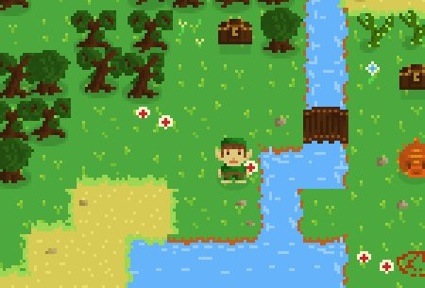 Nicolas Cannasse, Evoland
Nicolas Cannasse, Evoland
The exhibition text talks about the revival for pixelated, ASCII and geometrical games in the indie game scene. Are the people who develop and play retro game the people who grew up with the games produced in the 1980s and 1990s. Or is this an entirely new generation? And by that question i guess i mean also “is this a question of nostalgia or aesthetics’?
Most of the time, it’s the new generation that creates this kind of pixelated, cubic or geometric video games. Of course, some are older and have a certain nostalgia for the aesthetics of 1980s games but I think that the key is not in the nostalgia. First of all, there is a reaction to the ultra clean aesthetic of mainstream games. There is also the desire to express yourself with the new tools currently available. So I think it’s mostly a matter of aesthetics, of finding your own, whether it is closer to drawing, cubism, watercolor, pixel or 3D. I feel that there is a desire to think outside the box and to offer something else. Anne Roquigny was telling me this afternoon that the same phenomenon happens in online creativity today: the comeback of the gifs animated, of neon colors and of an aesthetic more or less close to the one of 1990s net.art. Both the web are the design tools are more accessible so creativity expresses itself in all kinds of directions. And I do not think that we’re speaking about nostalgia here either, mainly because this movement is unknown to new generations!
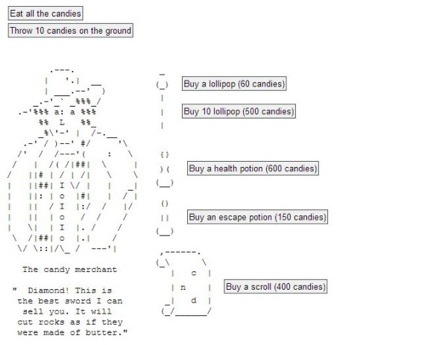 Aniwey, Candy Box
Aniwey, Candy Box
Merrit Kopas, HUGPUNX
Zak Ayles, PUNKSNOTDEAD
Do you see ‘arty’, independent games ideas and trends (such as retogaming) filtering into the commercial gaming world?
Yes, very much. As soon as a new “niche” appears, marketing lays its hands on it. That’s how the Playstation has its indie corner. Or why, for example, many complained about the excessive presence of sponsors with booths such as the Nintendo one during the last IndieCade. The “indie game” has become a new standard, an argument that sells. The success of games like Limbo and Minecraft have opened a new path. The use of old games or pixelated aesthetic is recurrent on mobile platforms. Yes, it has grown into a real business which, in this case, very often plays on nostalgia …
Carjacked (After Barbara Kruger), Colleo, 2013
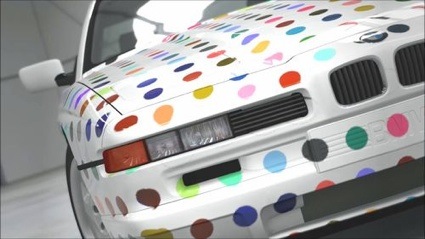 Carjacked (Racing after Hirst), Colleo, 2012
Carjacked (Racing after Hirst), Colleo, 2012
Carjacked, one of the works you selected for Games Reflexions, consists of 17 BMW cars created by Coll.eo with the Livery editor of the videogame Forza Motorsport 4 for the Xbox 360. The cars are customized ‘by’ famous contemporary artists. It is also a parody of the contemporary art world. But if the world of gaming is looking at the world of contemporary art, is the opposite true? Are art galleries, museums and collectors interesting in video games?
When MOMA added video games to its collection, even if it was in the department of design, it caused a stir in the contemporary art world. Gallery and museum initiatives are still relatively rare. The Stedelijk Museum in Amsterdam produced, two years ago I think, three games co-designed by artists and game designers. Game art exhibitions are still fairly marginal in this type of cultural structures. The Arcade exhibition in France toured many national exhibition spaces. This kind of exhibition is usually initiated by independent structures such as the collective Babycastles in the United States. The Cité des Sciences in Paris is about to host a major exhibition about video games but this is not a Museum of Contemporary Art. I feel, but I could be wrong, that for the moment this kind of creation follows the same parallel logic as media art. However, some artists like Miltos Manetas, Invader and Cory Arcangel who are close to the world of video games are definitely present in the art world. It is actually becoming difficult to show their work outside that network … ;)
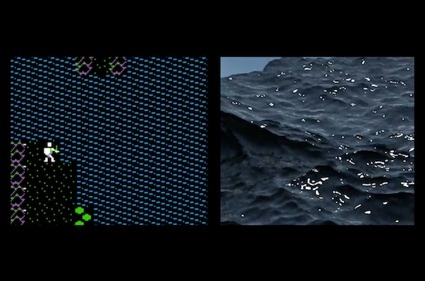 Harun Farocki, Parallel (still), 2012. Two-channel video installation
Harun Farocki, Parallel (still), 2012. Two-channel video installation
I’m always completely blown away by the selection of video games that you make for the GAMERZ festival every year. I’m also obviously impressed by your knowledge and understanding of the game scene. Are there any books, websites, blogs or other resources you could recommend to people who are not so versed into the world of video game but would like to know more about it?
Thank you! I feel the same about we- make-money-not- art! More than books -even though I recommend Rise of the Videogame Zinesters, by Anna Anthropy, and The Art of Immersion, by Franck Rose, which I liked a lot- I strongly believe in the network. The network of artists, designers and game developers. They are my first resource. I follow the twitter accounts of developers, the Facebook accounts of close and not-so-close friends from the world of video game, 8 bit music or digital art. One of the best references for me is the gamescenes.org site. For the exhibition Reflections Games, I asked Peter Corbinais of Oujevipo for a few tips and he sent me some fifty references! I am also very attentive to what is happening in schools in France and abroad. I follow the projects of the LA Game Space, the Game Department led by Eddo Stern at UCLA. Another resource that has thaught me a lot is the Scratchware manifesto written in 2000 and republished by Mike Myer one or two years ago.
Might and Delight, Shelter
And does the work of a video game curator involve daily hours of video game playing?
The preparation of an exhibition requires a lot of that. The rest of the time I do what i can, especially when I’m traveling. But my job obviously involves playing and it’s been going on for a while. However, if we look at this year as an example, I spent more time working on issues of borders than playing. Even if there are two games in the antiAtlas des frontières exhibition, that’s not what prevails. Playing takes time and I don’t have much to spare. However, what is great is that what comes out of most game jams are mainly games that can be played quite fast, and that’s brilliant for me! That said, I also spend a lot of time making machinimas during workshops and again they require me to practice. I actually dream of a residency where I’d spend several months testing every conceivable games to create the best machinimas…
Merci Isabelle!
Games Reflexions runs from 19 October until 30 November 2013 at Le Carreau in Cergy.
Isabelle Arvers has two other shows that just opened in France: Machiniglitch, at ARCADE, Festival Gamerz and The antiAtlas of Borders, at the Tapestry Museum, Aix-en-Provence.
See also this other interview i made with her 3 years ago: Machinimas at the GAMERZ festival.
Santa Ragione and Paolo Tajé, Mirror Moon
The Fullbright Company, Gone Home
—————————–
And now for the original version in french:
Bonjour Isabelle! Why do you think that now is a good time to reflect upon gaming? And more particularly about the relationship between our perception/construction of reality and video games.
Je ne sais pas si c’est le bon moment mais il me semble que le jeu a pris différentes formes et directions qui permettent de l’envisager dans une plus grande complexité qu’auparavant. Les games studies se sont développées dès les années 80 et ont permis d’appréhender le jeu sous différentes facettes : de la psychanalyse, à l’économie, en passant par la phylosophie, la science politique, etc. La réflexion liée à la question du jeu vidéo n’est donc pas nouvelle, par contre, le jeu commence à être perçu différemment par le public, les médias, il me semble donc bon d’accompagner ce mouvement en posant cette question au sein d’une exposition dans un espace d’art contemporain.
La question de la perception est pour moi très importante et ce, depuis mon mémoire sur le virtuel écrit au milieu des années 90 où je me demandais comment le virtuel pouvait influencer notre corps et notre esprit ? Je continue à me poser ce type de question : chaque technique, logiciel, langage influence notre manière de concevoir les choses et d’appréhender le réel, du coup qu’en est-il pour les jeux vidéo ? Un jour, des étudiants, fans de jeu vidéo, m’avaient dit rêver en images de synthèse et même préférer ce type d’image à celle qu’ils pouvaient voir à la télé, parce que c’était plus beau. J’avoue que cela m’a profondément marquée.
Je me suis dit alors dit que les jeux vidéo influencent notre imaginaire comme le faisaient autrefois les contes. Depuis que je fais des machinimas, je ne vois pas non plus les villes ni le mouvement dans les villes de la même manière, j’ai la sensation que les gens avancent comme dans les jeux… Toutes les idées liées à d’autres réalités me séduisent aussi. En réfléchissant à cette exposition, j’ai repensé à la caverne de Platon, à ces idées dont nous ne percevons que le reflet. L’idée qu’il y ait des mondes parallèles m’attire et j’aimerais beaucoup les imaginer à travers des jeux.
J’attends encore que des images de synthèse me renvoient à quelque chose qui ne se voit pas, j’attends qu’elles m’amènent de l’autre côté… Alors que pour la plupart des jeux qui cherchent à mimer la réalité, ils ne produisent qu’une image trop nette, trop lisse, qui me semble bien éloignée de ce que j’aimerais y découvrir. C’est pourquoi, quand j’ai découvert la compilation Pirate Kart et la quantité de jeux aux univers si divers, trash et drôles, j’ai eu envie d’aller dans cette direction et de les montrer dans le cadre d’une galerie. Lors de l’exposition de la Pirate Kart à la galerie de l’ESAix , ce qui m’a fait le plus plaisir c’est que des personnes m’ont dit que ça leur redonnait confiance, qu’ils faisaient ce genre de jeux chez eux mais ne pensaient pas que ça puisse intéresser qui que ce soit. C’est un peu l’envie d’ouvrir des possibles et de faire sortir ces perles du monde des game jams et du cercle des jeux indépendants afin de les faire découvrir au plus grand nombre.
The exhibition talks also about the quest for hyper-reality, are you already seeing interesting game experiences that use the Oculus Rift? is this something you’re following or are excited about?
C’est amusant car justement ce week-end, dans le cadre du festival Retro no Future Games Festival à Visages du Monde – qui est aussi le commanditaire de l’exposition Games Reflexion – le jeu Cosmic Forest d’Evilion était présenté avec Oculus Rift et là on touche presque au but !! Dans ce jeu, on parcourt des lignes et des colonnes de couleurs, comme si on pouvait passer entre les cordes… Cette direction de travail est intéressante dans la mesure où on s’immerge dans l’image, la perception de ce que voient nos yeux devient alors prédominante et parvient à induire le reste du corps en erreur.
Ce qui m’intéresse le plus aujourd’hui c’est justement l’aspect physique que peuvent prendre certains jeux et nous permettre de vivre des expériences différentes entre êtres humains. Je pense ici aux jeux pervasifs des Blast Theory qui au travers de jeux qui se jouent en ligne et dans l’espace public, s’intéressent aux nouveaux types de relations que les technologies peuvent créer au détour d’une rue, d’un obstacle. Ou encore au jeu Johann Sebastian Joust qui joue sur le contact entre des joueurs à l’écoute du rythme de la musique. Comment le jeu peut nous emmener ailleurs sans que ce soit pour autant uniquement dans un univers virtuel. J’aime aussi beaucoup la démarche de Florian Rivière qui transforme tout espace en un terrain de jeu, qui réintègre la notion de jeu grâce au plus petit détail : des choses trouvées dans la rue détournées pour devenir des baby foot, des terrains de baskets, un tourniquet… C’est dans cet esprit que le jeu Scintillations de David Calvo a été créé pour l’exposition Games Reflexion. Il vient rappeler que chacun doit se faire sa propre exposition et que chacun peut jouer avec les contenus, les détourner se les approprier.
The exhibition text talks about the revival for pixelated, ASCII and geometrical games in the indie game scene. Are the people who develop and play retro game the people who grew up with the games produced in the 1980s and 1990s. Or is this an entirely new generation? And by that question i guess i mean also “is this a question of nostalgia or aesthetics’?
C’est très souvent la nouvelle génération qui crée ce type de jeux vidéo pixellisés, cubiques ou géométriques. Bien entendu il y en a qui sont plus âgés et qui ont une certaine nostalgie pour l’esthétique des jeux des années 80, mais je pense que l’essentiel n’est pas dans la nostalgie. Il y a tout d’abord une réaction vis à vis dune esthétique trop propre des jeux mainstream. Il y a aussi l’envie de s’exprimer avec les nouveaux outils accessibles aujourd’hui. Je pense donc que c’est surtout une question d’esthétique, de trouver la sienne en propre, qu’elle soit proche du dessin, du cubisme, de l’aquarelle, du pixel ou de la 3D, j’ai la sensation qu’il y a une envie de sortir des sentiers battus et de proposer autre chose. Anne Roquigny me faisait remarquer tout à l’heure qu’il se passe exactement la même chose dans la création en ligne aujourd’hui : c’est le grand retour des gifs animés, des couleurs fluo et d’une esthétique plus ou moins proche de celle du net.art des années 90. Le web est plus accessible, les outils de conception le sont aussi alors la création s’exprime dans toutes les directions. Et je ne pense pas qu’il s’agisse de nostalgie là non plus, principalement parce que ce mouvement est très méconnu des nouvelles générations !
Do you see ‘arty’, independent games ideas and trends (such as retogaming) filtering into the commercial gaming world?
Oui, énormément. Dès qu’il y a un nouveau « créneau » le marketing s’en empare. C’est ainsi que Playstation a son carré inde, que lors du dernier Indiecade, beaucoup se sont plaint de la trop forte présence des sponsors avec des stands comme celui de Nintendo par exemple. Le « jeu indé » est devenu une nouvelle référence, un argument qui fait vendre. Les succès de jeux comme Limbo ou Minecraft ont ouvert une nouvelle voie. Le recours aux anciens jeux ou aux esthétiques pixellisées est récurrent sur les plateformes mobiles, oui c’est devenu un véritable business qui ici, joue très souvent sur la nostalgie…
Carjacked consists of 17 BMW cars created by Coll.eo with the Livery editor of the videogame Forza Motorsport 4 for the Xbox 360. The cars are customized ‘by’ famous contemporary artists. It is also a parody of the contemporary art world. But if the world of gaming is looking at the world of contemporary art, is the opposite true? Are art galleries, museums and collectors interesting in video games?
Lorsque le MOMA a intégré des jeux dans sa collection, même si c’est dans le département du design, cela a fait grand bruit dans le monde de l’art contemporain. Pour autant les initiatives de galeries ou musées sont encore assez rares. Le Stedelijk Museum à Amsterdam avait produit il y a deux ans je crois trois jeux conçus conjointement par des artistes et des game designers. Les expositions de game art ont encore assez peu lieu au sein de structures culturelles de ce type. L’exposition Arcade en France a tourné dans de nombreuses scènes nationales. Ce genre d’exposition est plutôt le fait d’indépendants comme le collectif Babycastle aux Etats Unis. La Cité des Sciences à Paris va bientôt accueillir une exposition importante de jeux vidéo mais on ne peut pas parler de Musée d’art contemporain. J’ai l’impression, mais je peux me tromper que pour l’instant ce type de création suit la même logique parallèle de diffusion que celle du media art. Par contre quelques artistes comme Miltos Manetas, Invader ou Cory Arcangel, que l’on peut rapprocher de l’univers des jeux vidéo sont bien présents dans le monde de l’art, il devient d’ailleurs difficile de les montrer en dehors de ce circuit… ;)
I’m always completely blown away by the selection of video games that you make for the GAMERZ festival every year. I’m also obviously impressed by your knowledge and understanding of the game scene. Are there any books, websites, blogs or other resources you could recommend to people who are not so versed into the world of video game but would like to know more about it?
Merci ! J’en aurais autant à dire de we-make-money-not-art !! Plus que des livres même si je recommande Rise of the Videogame Zinesters d’Anna Anthropy et The art of immersion de Franck Rose que j’ai beaucoup appréciés, je crois fortement au réseau. Au réseau d’artistes, de créateurs et de game developers, ce sont eux qui sont ma première ressource. Je suis les comptes twitters de développeurs, les comptes Facebook d’amis proches ou lointains du monde du jeu, de la musique 8 bit ou de l’art numérique. Une des meilleures références reste pour moi le site gamescenes.org. Pour l’exposition Games Reflexions, j’ai demandé quelques conseils à Pierre Corbinais du site Oujevipo et il m’a envoyé une cinquantaine de références ! Je suis aussi très à l’écoute de ce qui se passe dans les écoles en France et à l’étranger. Je suis ce qui sort du LA Game Space du département jeu de UCLA dirigé par Eddo Stern. Une autre ressource qui m’a beaucoup apporté est le Scratchware manifesto apparu en 2000 et republié ensuite par Mike Myer il y a un an ou deux.
And does the work of a video game curator involve daily hours of video game playing?
Pour la préparation d’une exposition ça en demande énormément, le reste du temps c’est comme je peux, surtout dans les transports. Mais c’est sûr que mon travail implique de jouer et que ça commence à faire un moment que ça dure ! Par contre, si on prend cette année en exemple, j’ai beaucoup plus travaillé sur la question des frontières que passé du temps à jouer, même si il y a deux jeux dans l’exposition antiAtlas des frontières antiatlas.net, ce n’est pas ce qui prédomine. Jouer demande du temps et ce n’est pas ce que j’ai le plus, par contre, ce qui est génial dans la plupart des game jams c’est qu’il en ressort beaucoup de jeux qui se jouent assez vite, et ça pour moi c’est formidable ! Ceci étant dit, je passe aussi beaucoup de temps à réaliser des machinimas dans le cadre d’ateliers et là aussi il faut pratiquer, d’ailleurs je rêve d’une résidence me permettant de passer plusieurs mois à tester tous les jeux possibles et imaginables pour réaliser au mieux des machinimas…
